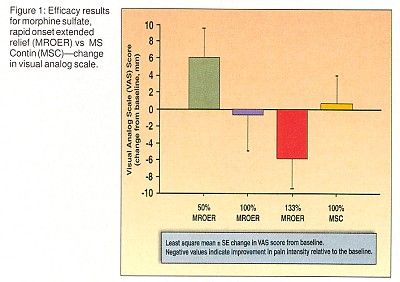Once-Daily, Rapid-Onset Morphine Offers Alternative for Those in Severe Pain
SAN FRANCISCO-A new morphine formulation that combines immediate-release and extended-release beads offers a once-daily alternative to the controlled-release morphine formulation MS Contin (MSC). A study compared the new product, once-daily Morphelan (morphine sulfate, rapid onset extended relief [MROER]), a convenient and effective option for pain management, with twice-daily MSC.
SAN FRANCISCOA new morphine formulation that combines immediate-release and extended-release beads offers a once-daily alternative to the controlled-release morphine formulation MS Contin (MSC). A study compared the new product, once-daily Morphelan (morphine sulfate, rapid onset extended relief [MROER]), a convenient and effective option for pain management, with twice-daily MSC.
Mary Simmonds, MD, and colleagues presented a subgroup analysis of the 39 cancer patients included among 272 subjects randomized to either MSC (n=11) or one of three doses of MROER. The subgroup included 11 patients with lung cancer, 9 with breast cancer, 4 with pancreatic cancer, and 15 with other cancer types.
The MSC dose was set after a 7 to 21 day stabilization period, during which patients reached a favorable balance between adverse effects and analgesia, requiring four or fewer rescue doses of oxycodone (Percolone, Roxicodone) per day. The MROER doses were set at 50% (n = 11), 100% (n = 7), or 135% (n = 10) of the MSC stabilization dose. (Oxydocone rescue doses were 10% of the total daily dose of morphine).
Moderate-to-Severe Pain
The study enrolled adult patients with moderate-to-severe pain, requiring treatment with 60 to 1,000 mg of oral morphine equivalents per day. Dr. Simmonds said that the stabilization period was followed by a 7-day, double blind, double dummy, parallel-design period to evaluate the safety and efficacy of the new morphine formulation. It can also be given mixed in applesauce for patients who have difficulty swallowing.
The primary efficacy variables were pain intensity, as measured by change from baseline on the Visual Analog Scale (0=no pain, 100=excruciating pain). Pain intensity was also measured by change from baseline on the Pain Descriptor Scale (0=no pain, 227=excruciating pain). The third primary efficacy variable was change from baseline in the total amount of rescue medication required daily.

Effects on the primary efficacy variables were comparable for once daily MROER at 100% of the stabilization dose of twice daily MSC. (See Figure 1.) Side effects were comparable and were those generally associated with opioids such as headache, nausea, somnolence, and constipation.
"Once-daily MROER and twice daily MSC were clinically comparable in pain control in cancer patients," Dr. Simmonds said. "The once-daily, rapid onset extended-release formulation offers a convenient and effective option for pain management in these patients."
Newsletter
Stay up to date on recent advances in the multidisciplinary approach to cancer.
Elevating the Quality of Cancer Care via Cross-Department Collaboration
Experts from Sibley Memorial Hospital discuss how multidisciplinary work has enhanced outcomes such as survival and resource use at their institution.
Artificial Intelligence in Cancer Care: Addressing Challenges and Health Equity
Artificial intelligence may mitigate overdiagnosis and unnecessary treatments in cancer cancer care by integrating with precision medicine.